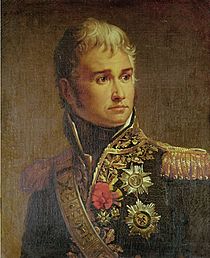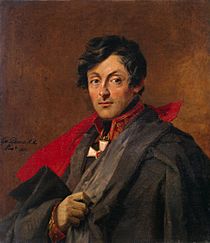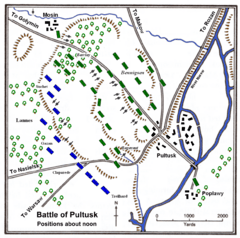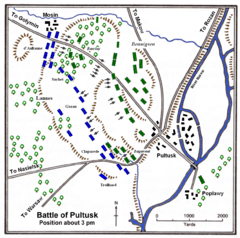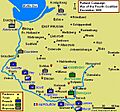Battle of Pułtusk (1806) facts for kids
Quick facts for kids Battle of Pułtusk |
|||||||
|---|---|---|---|---|---|---|---|
| Part of the War of the Fourth Coalition | |||||||
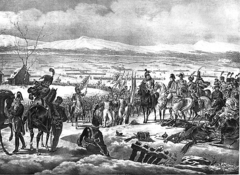 Battle of Pułtusk 1806 |
|||||||
|
|||||||
| Belligerents | |||||||
| Commanders and leaders | |||||||
| Strength | |||||||
| 25,000-27,000 soldiers | 40,000-45,000 soldiers, 128 guns, of which 35,000 engaged | ||||||
| Casualties and losses | |||||||
| unclear, see below | unclear, see below | ||||||
The Battle of Pułtusk happened on December 26, 1806. It took place near Pułtusk, a town in Poland. This battle was an important part of the War of the Fourth Coalition. Even though the Russian army had more soldiers and cannons, the French attacked them strongly. The Russians left the next day, having lost more soldiers than the French. This battle made their army very disorganized for a while.
Contents
Background to the Battle
Napoleon's Advance into Poland
After winning against the Prussian army in late 1806, Napoleon led his French army into Poland. His goal was to fight the Russian army. The Russians had been planning to help the Prussians, but the Prussians were defeated too quickly. French soldiers crossed the Vistula River and took control of Warsaw on November 28, 1806.
The main Russian army was led by Field Marshal Mikhail Kamensky. But he was old and unwell. The Russian First Army, with about 55,000 to 68,000 soldiers, was commanded by Count Bennigsen. They had moved back from the Vistula River to the Wkra River. They wanted to meet up with the Second Army, which had about 37,000 soldiers. This second army was still several days away.
Kamensky soon realized he made a mistake by letting the French cross the Vistula. So, in early December, he ordered his troops to move forward again. French forces crossed the Narew River on December 10. A Prussian group failed to take back Toruń. Because of this, Bennigsen decided on December 11 to fall back and defend the Wkra River line.
When Napoleon heard this, he thought the Russians were fully retreating. He ordered his generals, like Marshal Joachim Murat and Marshal Jean Lannes, to chase them towards Pułtusk. Other French forces moved to surround the Russian army.
Kamensky then changed his mind again. He ordered his troops to advance and help those on the Wkra River. On the night of December 23-24, French soldiers forced their way across the Wkra River in the Battle of Czarnowo. After more fights, the Prussian forces were pushed north.
Kamensky then ordered a retreat. But the old field marshal seemed to have a mental breakdown and left for Grodno. Bennigsen decided not to follow his superior's orders. He chose to stay and fight at Pułtusk on December 26. He had several divisions ready for battle. At the same time, another part of the Russian army fought the Battle of Gołymin nearby.
Challenging Weather Conditions
The weather was very difficult for both armies. The mild autumn had lasted longer than usual. Normally, the ground would freeze, making the bad roads easier to use. But instead, there were thaws. There was a thaw on December 17, and another on December 26 and 27.
This meant that both sides found it very hard to move their troops and supplies. The French army, who were advancing, had a lot of trouble moving their cannons. One officer wrote that it took two hours to travel only two and a half miles.
Getting supplies was also a big problem. A French captain wrote that it rained and snowed all the time. Food was very scarce, and there was hardly any good wine or beer. They also had no bread and often had to fight for shelter.
The Battleground at Pułtusk
Pułtusk is located on the west side of the Narew River. There is also a small part of the town on the east side. A road from Strzegociz crossed the river by a bridge and then went northwest towards Gołymin. Another road from Warsaw came into the town from the southwest. This road then ran along the west bank of the river.
Before reaching Pułtusk, this road joined another one from Nasielsk. There was also a longer route to Różan along the east bank. The last road went north from the town towards Markow. The town itself was on low ground. To the north and west, there was a higher area, like a plateau. A large forest was on the northwest side of this plateau. More forests covered the areas leading to Pułtusk from Warsaw.
The Battle Unfolds
Armies and Commanders
Marshal Jean Lannes led the French forces at Pułtusk. He had two main groups of infantry soldiers. One group was led by General Louis Gabriel Suchet, and the other by General Honoré Théodore Maxime Gazan de la Peyrière. Lannes also had cavalry (soldiers on horseback) and artillery (cannons). His army had about 25,000 to 27,000 soldiers.
The Russian army was commanded by Count Bennigsen. He had several divisions, including those led by General Alexander Ivanovich Ostermann-Tolstoy and General Alexander Karlovich Sedmoratski. The Russian army was much larger, with about 40,000 to 45,000 soldiers and 128 cannons. About 35,000 of these soldiers were actively fighting.
The Fight Begins
Bennigsen placed his soldiers along the road between Pułtusk and Gołymin. They were in three lines. His left side was near the town, and his right side was near the Mosin forest. The cannons were placed in front of the first line of soldiers. On the far right, General Michael Andreas Barclay de Tolly held part of the Mosin forest. He had three battalions, a cavalry group, and cannons.
Marshal Lannes was ordered to cross the Narew River at Pułtusk. He knew there were Russian soldiers, but he didn't know how many. His first troops arrived around 10:00 AM. They pushed back the Russian cavalry. Because of the land, Lannes could only see the Russian positions on the far left and right.
Lannes placed Suchet's division on his left, facing the Mosin forest. Gazan's division covered the rest of the Russian line. The few French cannons were placed on the left and in the middle.
Around 11:00 AM, the French right side attacked. They pushed back the Russian cavalry. The French center also moved forward. But this left them open to the Russian cavalry. Seven groups of Russian cavalry suddenly attacked the French side during a snowstorm. After a confused fight, the Russians went back to their original positions. The French cavalry tried to advance but were stopped by cannon fire.
At the same time, on the French left, Suchet's division attacked the position held by Barclay. Lannes himself led this attack. The first attack pushed the Russians out of the forest and captured their cannons. But Barclay's reserve troops pushed the French back into the forest and took back the cannons.
The French center also moved forward. The Russian cavalry moved back behind their main line. This left the French open to heavy fire from the Russian cannons.
Turning Point and Retreat
By about 2:00 PM, the French were in a difficult spot. The Russian left side was holding strong. The French center was suffering from cannon fire. On the right, the French were being pushed out of the forest. It looked like the French might have to retreat.
But then, unexpected help arrived. A division from another French army group, led by General Fournier, had been chasing a Russian group. Fournier heard the sounds of fighting and marched his soldiers towards Pułtusk. Because of the bad roads, he could only bring one cannon.
When Bennigsen saw this new French force, he moved his main line to face the forest. This reduced the cannon fire on Lannes's soldiers. Barclay, finding Fournier attacking his right side, moved back. Bennigsen sent more soldiers and cannons to help Barclay. With these new forces, Barclay attacked the forest. The French were pushed out, and Fournier's right side was exposed. Twenty groups of Russian cavalry attacked, but the French soldiers formed squares and fought them off. Around 8:00 PM, the fighting stopped.
The arrival of Fournier's division also helped the French right side. With many Russian cannons now focused on Barclay, the French could use their own cannons. Around 2:00 PM, they launched a new attack. The Russian soldiers were pushed back, and their cannons were captured. But then, the Russians attacked again. After a fierce fight, the French were pushed back, and the cannons were recaptured. As night fell, the French right and center went back to where they started.
During the night, Bennigsen decided to retreat. He left the next day, December 27, using a longer road. From there, he continued his retreat. Lannes was not able to chase the Russians. He occupied Pułtusk on December 28.
Aftermath of the Battle
At the Battle of Gołymin, which happened on the same day, Russian forces successfully held off a larger French army. This, along with another French general's failure to go around the Russian right side, ruined Napoleon's plan. He had hoped to cut off the Russian retreat and trap them against the Narew River.
The Russian forces moved back to meet the rest of their army. On December 28, Napoleon stopped his advance. He had lost track of the Russian army. He decided to set up winter camps for his soldiers. His troops were tired and unhappy, and getting supplies was very difficult.
The break in fighting did not last long. Soon after, Bennigsen became the main army commander. He launched a surprise attack in the winter. This attack was stopped at the Battle of Mohrungen in January 1807. Napoleon immediately attacked back. He tried to cut off the Russian supply lines. The French caught up with the Russians in February 1807, and the terrible Battle of Eylau was fought.
In Popular Culture
The Battle of Pułtusk is mentioned in the famous book War and Peace by Leo Tolstoy.
Images for kids



